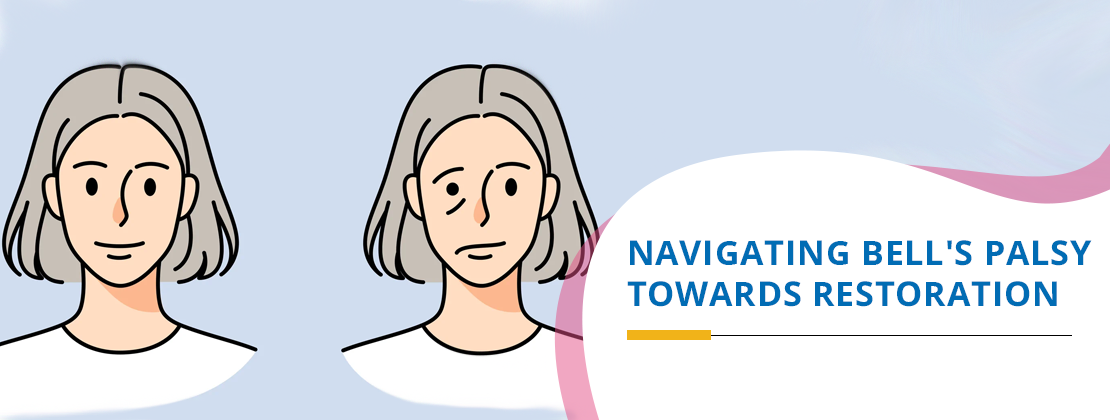
Home / Blog / Navigating Bell's Palsy Towards Restoration
Table of Contents
Bell’s Palsy, a condition wrapped in mystery, emerges as an unexpected antagonist in the lives of those it afflicts. Bell’s Palsy is a sudden onset of facial paralysis where one side of the face is rendered immobile, along with one’s facial expressions arrested mid-gesture. This abrupt intrusion into the realm of daily existence can send shockwaves through one’s emotional and physical landscape. The face, our primary mode of communication and expression, becomes a silent witness to the disruption wrought by this neurological enigma. In the wake of such upheaval, individuals find themselves grappling not only with the tangible loss of facial muscle function but also with the intangible complexities of emotional distress and psychological adjustment. The journey through Bell’s Palsy and its recovery is not merely a physical one but a profound exploration of resilience, adaptation, and the human spirit’s capacity to transcend adversity. Amidst the uncertainty, understanding Bell’s Palsy prognosis emerges as a ray of hope, guiding individuals towards informed decisions and a steadfast belief in the possibility of recovery.
Bell’s Palsy presents with a diverse array of symptoms, including abrupt weakness or paralysis on one side of the face, drooping mouth or eyelid, impaired taste sensation, and heightened sensitivity to sound. While the precise aetiology of Bell’s Palsy and its causes remains elusive, viral infections, particularly herpes simplex virus type 1 (HSV-1), are frequently implicated. Additionally, factors such as inflammation and immune system dysfunction may contribute to the onset of this condition. Understanding these symptoms and underlying causes is crucial for prompt recognition and targeted intervention.
Diagnosing Bell’s Palsy entails a comprehensive evaluation process aimed at differentiating it from other potential causes of facial paralysis. Healthcare providers typically conduct thorough physical examinations, assessing facial muscle strength, symmetry, and reflexes. Additionally, medical history inquiries and imaging studies, such as Magnetic Resonance Imaging (MRI) or Computed Tomography (CT) Scans, may be employed to rule out alternative conditions. Given the nuanced nature of Bell’s Palsy diagnosis, seeking professional medical guidance is paramount to ensure accurate assessment and specific treatment planning.
Despite its sudden onset, Bell’s Palsy often responds favourably to treatment, with the primary goals being to reduce inflammation, manage symptoms, and promote nerve regeneration. Corticosteroids, such as Prednisone, are commonly prescribed to mitigate facial nerve inflammation, while antiviral medications may be administered if viral involvement is suspected. Physical therapy plays a pivotal role in the rehabilitation process, encompassing exercises to strengthen facial muscles, improve coordination, and enhance facial symmetry. While the recovery trajectory varies among individuals, early intervention significantly enhances the prospects of complete recuperation, instilling hope and optimism in those affected by this condition.
Physical therapy serves as a foundation stone in the holistic management of Bell’s Palsy, offering targeted interventions to optimise facial muscle function and promote neuroplasticity. Therapeutic modalities, such as facial exercises, massage techniques, and electrical stimulation, are employed to stimulate nerve regeneration, improve muscle tone, and enhance facial mobility. Furthermore, education and counselling empower patients to actively participate in their recovery journey, fostering resilience and facilitating long-term functional gains. By integrating physical therapy into daily routines, individuals with the condition can embark on a path toward restoration and renewed confidence.
Beyond the realm of medical intervention, facial paralysis poses profound emotional and psychosocial challenges, necessitating robust support systems and effective coping mechanisms. The impact of facial paralysis extends beyond physical limitations, often encompassing feelings of self-consciousness, social isolation, and psychological distress. Engaging with supportive peers, family members, or online communities can provide invaluable encouragement, empathy, and practical advice. Additionally, seeking professional counselling or physical therapy offers a safe space to explore emotional complexities, develop coping strategies, and foster resilience in the face of adversity. By nurturing supportive networks and prioritising self-care, individuals with Bell’s Palsy can navigate the emotional landscape with greater ease and fortitude.
The field of neurology is witnessing remarkable strides in the treatment of Bell’s Palsy, driven by groundbreaking research and technological innovations. Emerging therapies, such as Neurotrophic Factors, Stem Cell Transplantation, and Facial Nerve Decompression Surgery, hold promise for enhancing nerve regeneration and optimising functional outcomes. Additionally, novel drug formulations and targeted interventions aim to modulate immune responses, attenuate inflammation, and mitigate neuronal damage. By embracing these cutting-edge treatments, healthcare providers can offer individuals with Bell’s Palsy access to the most advanced and effective care modalities, fostering a culture of innovation and excellence in neurological rehabilitation.
In conclusion, Bell’s Palsy represents a multifaceted clinical entity, characterised by sudden facial paralysis and myriad associated challenges. Through comprehensive understanding and proactive intervention, individuals can navigate the complexities of Bell’s Palsy with resilience, optimism, and determination. By leveraging the synergistic efforts of medical intervention, physical therapy, support systems, and technological advancements, we can unlock the mysteries of Bell’s Palsy and pave the way for improved outcomes and enhanced quality of life that will lead to a journey to recovery, restoration, and renewed vitality in the face of adversity.